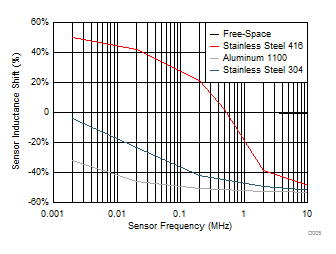SNOA957B September 2016 – June 2021 LDC0851 , LDC1001 , LDC1001-Q1 , LDC1041 , LDC1051 , LDC1101 , LDC1312 , LDC1312-Q1 , LDC1314 , LDC1314-Q1 , LDC1612 , LDC1612-Q1 , LDC1614 , LDC1614-Q1 , LDC2112 , LDC2114 , LDC3114 , LDC3114-Q1
4.4 Steel and Magnetic Material Targets
Steel and targets composed of magnetic materials can be used in LDC applications, but these materials can present special challenges for inductance measurements. In general, systems using these targets should have either ƒSENSOR < 20 kHz or ƒSENSOR > 1 MHz.
Steel has a lower conductivity than copper (typically <10% of copper). This reduces the amount of eddy currents generated on the surface of the target. As a result, the inductance shift due to target movement is reduced at lower sensor frequencies. The smaller inductance shift results in lower measurement resolution of the target movement.
Magnetic steels, such as Stainless Steel 416, produce a significantly different inductance response across sensor frequency, as shown in Figure 4-2. This behavior is caused by the magnetic field lines permeating the steel, which results in an increase in the sensor inductance, instead of a decrease in the inductance due to eddy currents. At higher frequencies, the skin depth becomes small enough that the eddy current generation on the surface of the steel blocks the magnetic field lines from entering the metal. At these higher sensor frequencies the inductance drops in a manner consistent with other conductive materials.
There is actually a frequency at which the magnetic permeability and eddy currents balance and there is no noticeable inductance shift. This frequency is not stable and can shift due to outside influences, such as temperature. This effect can actually result in a non-monotonic output for target movement. In addition, the sensor frequency changes due to target movement, and it is possible that the sensor frequency can shift to a poorer measurement accuracy range.
RP measurements do not have this issue, as the eddy current losses are still present.
 Figure 4-2 Shift in Sensor Inductance for Different Target Materials vs Frequency
Figure 4-2 Shift in Sensor Inductance for Different Target Materials vs Frequency